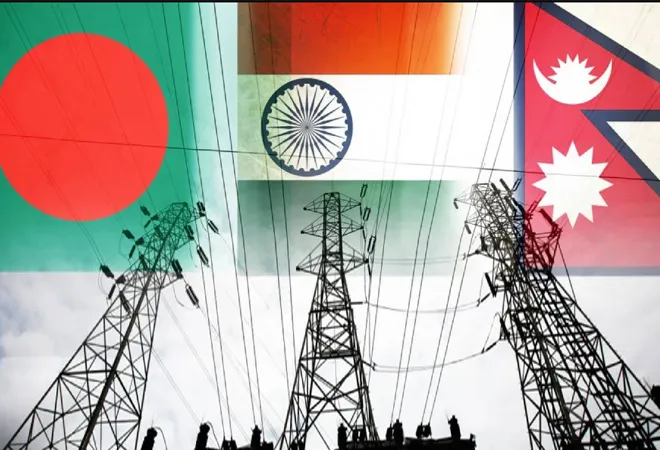-
CENTRES
Progammes & Centres
Location
In an evolving demand-supply equilibrium in South Asia, India is now emerging as an invisible hand that is facilitating economic integration, trade, and connectivity

Bangladesh will soon be signing a 25-year power sale deal with Nepal, through which the latter will export 40 megawatts of electricity. As geographical compulsions dictate, this power trade between Nepal and Bangladesh will have to pass through Indian territories. The trade agreement—already drafted—will soon be formalised once a tripartite agreement is signed between Nepal, Bangladesh, and India. The agreement will be the first of its kind where South Asian countries will trade power with each other via the Indian power grid. It is the realisation of a long-standing demand by Nepal and Bangladesh, and its implementation indicates the growing demands and importance of smaller South Asian nations, and India’s increasing efforts to promote connectivity, and counter Chinese presence in the neighbourhood.
The agreement will be the first of its kind where South Asian countries will trade power with each other via the Indian power grid.
Bangladesh has been struggling to meet the rising demand for electricity to cope with the sweltering weather, often lapsing into 10–12-hour-long power cuts. The civilians are not the only ones ‘losing sleep’ over the crisis as the business sector, especially the foreign-reserves-generating garment industry, is also experiencing losses. The root of the problem is the shortage in coal and natural gas supply that the country has been encountering since last year because of manifold reasons such as not using a state-owned company for exploring natural resources; making power production heavily dependent on natural gas; inflation of fuel prices due to the Russia-Ukraine conflict; rising prices of Liquified Natural Gas imports due to the European Union’s embargo on Russian crude oil; the OPEC+ cuts on oil production; soaring temperatures; and most recently, the impact of Cyclone Mocha, which cut off power supplies.
As a result, the country has been facing recurrent blackouts, with a national power grid failure occurring in October 2022, leaving almost 140 million people without electricity. On 5 June 2023, the 1.32-gigawatt second unit of the Payra plant was temporarily shut down due to a coal shortage, following the closure of the first unit on 25 May. After a suspension of 20 days, both units began functioning again in late June, only after a ship carrying 41,000 metric tonnes of coal docked at the Payra port. It is, thus, evident why the government of Bangladesh is keen to undertake power supply deals with its neighbouring countries. Furthermore, as Bangladesh Prime Minister Sheikh Hasina banks on the development card for her electoral win in the upcoming general elections, reassuring the nation about a ‘brighter future’ is essential, especially as the power crisis has already become a campaigning point for the Opposition.
The country has been facing recurrent blackouts, with a national power grid failure occurring in October 2022, leaving almost 140 million people without electricity.
On the other hand, with ample water resources, Nepal is keen to promote its hydropower exports. Hydropower exports have been a long-sold and cherished dream in Nepal. But the necessity to further realise this dream has doubled down with the external shocks of COVID-19 and the Russia-Ukraine conflict. These shocks triggered a decrease in domestic production, tourism, and remittances and increased its imports and inflation—pushing Nepal into a recession for the first time in six decades and severely depleting its forex reserves. This episode has pushed Nepal’s two fundamental issues to the forefront: Its import dependency and expenditure and fewer sources of forex generation.
In this regard, Bangladesh’s growing economy and power demand offer an opportunity for Nepal to promote hydropower exports. Kathmandu hopes that exports will bridge the trade gap and produce dollars and revenues for the government. Politically, connectivity with Bangladesh helps Nepali politicians take credit for fulfilling the long due hydropower dream of the country and transitioning Nepal from a land-locked to a land-linked country. It also enables them to cater to domestic nationalist sentiments by portraying themselves as “Davids” who pressurised Goliath “big brother” India to offer the nation some concessions. Nepali Prime Minister Prachanda’s recent statement about trading Kalapani for land access to Bangladesh through India’s sensitive Siliguri Corridor further substantiates these attempts to promote nationalist sentiments.
For India, this necessity for connectivity is a manifestation of its growing economy, infrastructure boom, and “Neighbourhood First” policy. To be clear, economic interests and needs had already compelled India to display its interest in developing hydropower projects and promoting bilateral power trade in the region. But in recent years, India’s economic needs and the China threat have increased the importance of South Asian countries for New Delhi. Effectively, India has shown tremendous interest in promoting energy connectivity, both bilaterally and within the region. There has been an increase in transmission networks and petroleum pipelines connecting India to the rest of the countries. In 2019, India constructed South Asia's first trans-border petroleum pipeline to Nepal, supplying 2.8 million metric tonnes of diesel. In March 2023, India and Bangladesh launched a core cross-border pipeline to supply one million metric tonnes of diesel annually. Similar plans for petroleum pipeline connectivity with Sri Lanka have been discussed in July 2023.
Politically, connectivity with Bangladesh helps Nepali politicians take credit for fulfilling the long due hydropower dream of the country and transitioning Nepal from a land-locked to a land-linked country.
Further, India has also increased its power supply arrangements with its neighbours. In an evolving demand-supply equilibrium in South Asia, India is now emerging as an invisible hand that is facilitating economic integration, trade, and connectivity in the region. In 2018, India relaxed its Cross-Border Trade of Electricity (CBTI) guidelines, which enabled the expansion of the Indian power market towards building an integrated South Asian Power Market. The grid connectivity has allowed countries like Bangladesh, Nepal, Bhutan, and Sri Lanka, to purchase and sell power through the Indian grid and participate in the Indian power exchanges. In addition, the revised CBTI guidelines also facilitate power trade between two countries through Indian transmission lines. Nepal and Bangladesh’s recent agreement for energy trading via India will be the first of its kind under these guidelines, and countries like Sri Lanka will also subscribe to such arrangements soon.
Another reason for India’s increased cooperation and engagement is China’s presence in the region. The data from the Bangladesh Bank in 2021 revealed that “China has a total stock of foreign direct investment in Bangladesh's power sector amounting to US$450 million, all in fossil fuel-based power plants.” Moreover, the Bangladesh Working Group on External Debt shared that two operational coal-fired power plants with a combined capacity of 1,845 MW are backed by Chinese companies; another five thermal plants with a generation capacity of 4,460 MW have Chinese investments. However, in September 2021, Chinese President Xi Jinping announced that “China would step up support for other developing countries in generating green and low-carbon energy and would not build new coal-fired power projects abroad,” at the United Nations General Assembly. Subsequently, with Bangladesh continuing to depend on heavy fuels for nearly 42 percent of its power generation, there is a need to tap into other power sources such as imported electricity (currently accounting for only 5 percent of Bangladesh’s electricity). This increases India’s power sector investment opportunities.
India is the only country that exports electricity from Nepal, and its revised CBTI guidelines restrict Chinese-funded or assisted power plants from exporting electricity to India or its neighbouring countries through the Indian grid.
On the other hand, Chinese investments in Nepal’s hydropower sector have been sub-par for Kathmandu. While China has invested and assisted in hydropower projects—as seen with the Marsyangdi and Tamakoshi projects—it is facing multiple challenges. For one, India is the only country that exports electricity from Nepal, and its revised CBTI guidelines restrict Chinese-funded or assisted power plants from exporting electricity to India or its neighbouring countries through the Indian grid. Second, while some Chinese firms have withdrawn from the country due to political instability, technical difficulties, and low returns, other hydropower BRI projects have made no progress due to Nepal’s resistance to Chinese commercial loans. Eventually, India has replaced China and taken the lead in four of these projects. And with China now making progress in the cross-border power grid with Nepal, India is trying to up its game. It is assisting Nepal to expand its trade partners (read Bangladesh); promote additional interdependence and connectivity in the region; be more sensitive to its neighbours’ demands; and limit Chinese presence and influence in the region.
Thus, as the competition in the region intensifies, India is redefining “power” in South Asia through its connectivity efforts. This is a product of the growing domestic needs and importance of South Asian countries, India’s increasing interest in facilitating connectivity, and countering the Chinese presence in the region.
Aditya Gowdara Shivamurthy is a Junior Fellow at the Strategic Studies Programme at Observer Research Foundation.
Sohini Bose is a Junior Fellow with the Strategic Studies Programme at the Observer Research Foundation.
The views expressed above belong to the author(s). ORF research and analyses now available on Telegram! Click here to access our curated content — blogs, longforms and interviews.

Aditya Gowdara Shivamurthy is an Associate Fellow with the Strategic Studies Programme’s Neighbourhood Studies Initiative. He focuses on strategic and security-related developments in the South Asian ...
Read More +
Sohini Bose is an Associate Fellow at Observer Research Foundation (ORF), Kolkata with the Strategic Studies Programme. Her area of research is India’s eastern maritime ...
Read More +